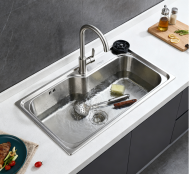The key to selecting stainless steel lies in corrosion resistance. The main difference between 304 and 316 is the presence of Molybdenum (Mo)
1. Composition
l 304: Chromium (18-20%), Nickel (8-10.5%).
l 316: Adds 2-3% Molybdenum to 304's base.
2. The Key Differentiator: The Decisive Role of Molybdenum (Mo)
l Molybdenum drastically improves resistance to chlorides.
l 316 effectively resists "pitting corrosion" from seawater, de-icing salts, etc., offering superior corrosion resistance.
3. Application Guide: How to Choose Based on Environment
l Type 304: Is the versatile, general-purpose choice suitable for most interior and mild atmospheric exposures.
Examples include kitchen equipment, architectural trim, household appliances, and water tanks.

(SUS 304)
l Type 316: Is the superior choice when your project faces more aggressive conditions. Thanks to its superior corrosion resistance
it is widely used in coastal building facades, marine components, chemical processing equipment, and industrial facilities exposed to de-icing salts or saltwater spray.

(SUS 316)
316 provides stronger defense against corrosion, especially against pitting, thanks to Molybdenum.